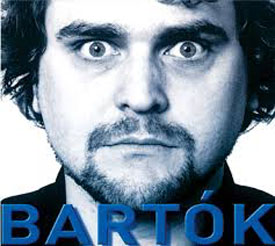 If I seem to be enthusiastic about the music of Béla Bartók, it’s only because I am — you’d have to be, to sit and listen to more than five hours of his music for solo piano. Happily, he was fairly prolific as a composer.
If I seem to be enthusiastic about the music of Béla Bartók, it’s only because I am — you’d have to be, to sit and listen to more than five hours of his music for solo piano. Happily, he was fairly prolific as a composer.
The works presented on this disc from 2L provide a good illustration of the composer’s approach to composition at various times in his career through some of his chamber music, which to me is always one the best ways to find out what a composer is thinking.
The Sonata for Violin is Bartók’s last completed work, commissioned by violinist Yehudi Menuhin. Due to disagreement between composer and soloist, the work was unperformed before Bartók’s death in 1945, and the first publication contained Mehuhin’s alterations rather than the original notation. It is a complex work in grand scale, tight and lyrical, with full play given to the possibilities inherent in the tension between melody and counterpoint.
That Bartók was able to achieve a basic synthesis of folk music and a modernist vocabulary is evident from the very beginning of the Sonata for Violin. The first few bars leave no doubt that this music has a great deal to do with Hungary, and yet it is not anything to do with any melodies that are characteristically Hungarian. The composer has incorporated the basic structures of folk music into a thoroughly modern piece of music.
The Sonata No. 2 for Violin and Piano offers a good example of some of the interactions between Stravinsky’s music and Bartók’s music in the early 1920s, discussed by by David E. Schneider in his essay on Bartók and Stravinsky in Peter Laki’s Bartók and His World. At this time Bartók was heavily engaged in research into Hungarian folk music and had appreciated Stravinsky’s similar researches, although apparently somewhat concerned about Stravinsky’s move to a “neo-classical” style. It is a spare work — one can also detect traces of the music of Arnold Schoenberg, another composer with tremendous influence on the music of the period. Often moody, thoughtful, and compared to many of Bartó’k’s earlier compositions, understated, it is also vivid and has moments of surprising — and very contemporary — energy.
The Contrasts for Violin, Clarinet and Piano of 1938 was one of those surprising things that used to happen with “serious” music: it was commissioned by Hungarian violinist Jozef Szigeti and Benny Goodman, the “King of Swing.” The first performance, in 1939, was of the two-movement first version, followed the next year by a second performance, with Bartók at the piano and a new third movement inserted in the middle, the version recorded here. It’s almost impossible not to think of jazz when hearing Contrasts, but that is only one of the possibilities, and it’s instructive that a composer who wasn’t particularly interested in the commission when he first agreed to it came up with the work as it now stands. Again, there is the nationalist influence, reflected even in the titles of the movements — verbunkos, pihenö, and sebes, all titled after Hungarian folk and vernacular music forms. There are, indeed, contrasts in this music — of mood and tempos, of jazz and modernist idioms, indeed, even in the tuning of one of the violins — the violinist needs two, one tuned traditionally and the other tuned in tritones, a characteristic of the folk music of Eastern Europe. It is the shortest piece on the disc, and also the lightest in mood.
The three performers on this collection, Annar Follesø (violin), Christian Ihle Hadland (piano), and Björn Nyman (clarinet), are all distinguished musicians with a predilection for chamber music. They are obviously sympathetic to these works and make this collection a good addition to the basic Bartók library.
(2L, 2004) [Annar Follesø, violin; Björn Nyman, clarinet; Christian Ihle Hadland, piano]
